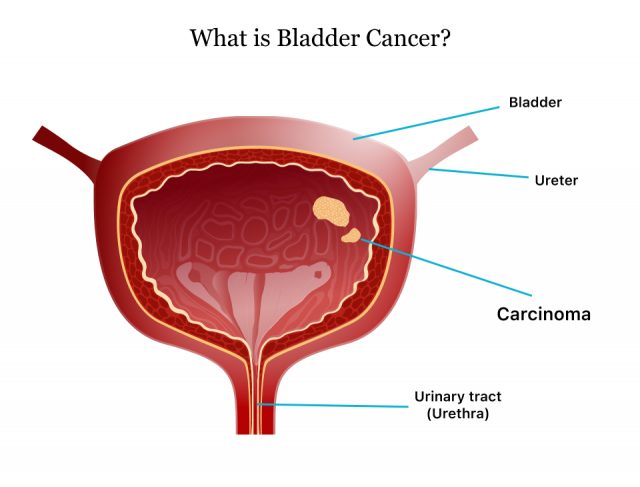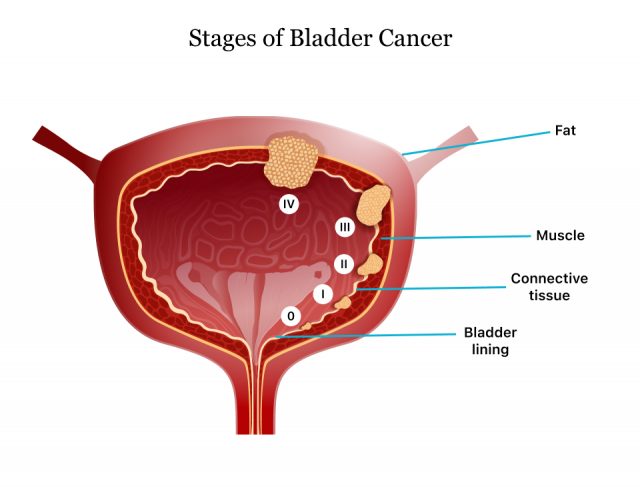Bladder Cancer
Bladder cancer happens when cells in the bladder grow out of control and form tumors. It occurs most often in older people, and can spread to other body parts if left untreated. This guide will help you better understand bladder cancer warning signs, causes, treatments and survival rates.
The American Cancer Society estimated about 81,180 new cases of bladder cancer in 2022. About 90 percent of people with bladder cancer get it after age 55, and the average age for diagnosis is 73.
This type of cancer is more common in men than in women. In recent years, incident rates of bladder cancer have decreased, especially among women.
If found early, bladder cancer usually responds well to treatment.
- First signs of bladder cancer include pain during urination and blood in the urine.
- Bladder cancer treatment includes surgery, radiation, chemotherapy, immunotherapy or targeted therapy.
- On average, the five-year bladder cancer survival rate is 77 percent.
- If cancer hasn’t spread outside the bladder, the five-year survival rate is 96 percent.
- Bladder cancer can come back after treatment.

Warning Signs of Bladder Cancer
One of the most common and early signs of bladder cancer is blood in the urine, also called hematuria. If enough blood is present in the urine, it might be visible to the naked eye. Other times, only a urine test can detect it.
Some people might not have early symptoms.
- Blood in the urine
- Burning sensations while urinating
- Feelings of having to urinate but not being able to
- Frequent urination
- Lower back pain
- Painful urination
- Pelvic pain
Bladder cancer symptoms resemble the symptoms of other health conditions, and it’s important to check with your health care provider to rule them out. If you have any of these symptoms, make sure to make an appointment right away, especially if you have a family history or risk factors.
Symptoms in Men and Women
Bladder cancer symptoms in men and women are the same. Men are more likely to get bladder cancer, but they are also more likely to have it diagnosed earlier, according to Moffitt Cancer Center.
Women are more likely to mistake bladder cancer symptoms for urinary tract infections or menstruation.
Rarely, bladder cancer may also be misdiagnosed as interstitial cystitis in women. IC is a painful, inflammatory bladder condition that affects more women than men.
In one study, doctors found bladder cancer in about one percent out of 600 patients referred to them for IC treatment, according to an article in Urology Times.
Bladder Cancer Survival Rates
Survival rates don’t tell a person how long they will live, but they can predict how likely it is that treatment will succeed. People whose cancer hasn’t grown past the bladder have a better at living for at least five years with treatment.
These are just guidelines and don’t necessarily apply to each individual person’s case. If you have questions about your specific prognosis and survival chances, talk to your doctor.
- Average overall – 77 percent
- In situ (local tumor) – 96 percent
- Localized (tumor has spread, but not outside the bladder) – 69 percent
- Regional (spread from bladder to nearby structures or lymph nodes) – 37 percent
- Distant (spread to other organs and parts of the body) – 6 percent
Diagnosis
Medical providers use a variety of tests to confirm or rule out bladder cancer. These include physical exams, lab tests and imaging tests.
Providers will also order tests to see how far the cancer has spread.
- During a physical exam, the medical provider looks for signs of disease such as a lump or unusual growth. They will also ask about your family history, health problems and lifestyle, such as if you smoke.
- They may also do an internal exam. This involves inserting gloved fingers into the rectum or vagina to feel for lumps.
- A urinalysis is an examination of the color and contents of urine. Providers will look for blood cells, sugar, protein and other contents.
- Providers check urine under a microscope to look for cell abnormalities.
- Doctors insert a thin tube with a light on it called a cystoscope into the bladder to check for abnormalities. Instruments attached to the cystoscope can remove tissue samples for study.
- Removing tissues or cells is called a biopsy.
- An IVP takes a series of x-rays of the bladder, kidneys and ureters to look for cancer. Doctors will inject contrast dye into the body to look for tumors or blockages.
- A biopsy takes tissue or cell samples so a pathologist can examine them. Doctors may even remove an entire tumor during a biopsy.
Treatment by Stage
Bladder cancer stages go from zero to four (0 to IV). As the cancer spreads, the stage goes up.
Doctors will recommend different types of treatment based on the cancer’s stage. Higher-staged cancers are more difficult to treat and have a poorer prognosis.

Stage 0
Stage 0 cancer is still in the inner lining of the bladder and hasn’t gone deeper into the bladder wall. It’s usually treated with transurethral bladder tumor resection (TURBT) followed by intravesical chemotherapy.
TURBT involves inserting a cystoscope into the bladder to remove the tumor. Intravesical, or local, chemotherapy means doctors will inject medicine directly into the bladder.
In general, prognosis for people with non-invasive papillary cancer (stage 0a) is good and is less favorable if it’s flat non-invasive (stage 0is).
Stage I
Stage I cancer has spread out of the bladder lining and into the connective tissues of the bladder wall. Treatment for this cancer is TURBT followed by intravesical chemotherapy or intravesical Bacillus Calmette-Guerin or BCG immunotherapy. This keeps the cancer from growing or coming back.
The doctor may remove part or all of the bladder. For people who can’t have major surgery, radiation therapy might be used. Radiation isn’t as effective as surgery to remove the tumor.
Stage II
Stage II cancer has spread into the bladder muscle but hasn’t spread outside the bladder. The standard treatment for Stage II cancer is removal of part or all of the bladder. Before surgery, doctors may recommend chemotherapy to shrink the tumor. For some patients, chemotherapy may be accompanied by radiation therapy.
Stage III
Stage III cancers have spread beyond the bladder to nearby structures and organs. The first line of treatment is chemotherapy and removal of the entire bladder.
Patients may have another round of chemotherapy after surgery. Radiation therapy may be needed if cancer has spread to lymph nodes.
Stage IV
Stage IV cancers are very difficult to get rid of because they have spread to the pelvis, abdomen and distant body parts. Standard treatments are chemotherapy, radiation, immunotherapy and surgery to remove tumors. It’s rare to be able to remove all tumors with surgery.
Treatments are unlikely to cure stage IV cancers and doctors may recommend joining a clinical trial.
Causes and Risk Factors
Researchers don’t know exactly what causes bladder cancer, but they do know what increases the risk of getting it. These risk factors range from family history to certain types of medication.
- Certain kinds of chemotherapy drugs
- Chronic urinary tract infections
- Drinking chlorinated water
- Drinking water with arsenic contamination
- Exposure to workplace chemicals used to process petroleum products, metal, dye and paint
- Family history
- Genetics
- Ingesting a Chinese herb called Aristolochia fangchi
- Long-term urinary catheter use
- Radiation therapy to the pelvis
- Smoking
Medications That May Increase Bladder Cancer Risk
Studies have found that some medications may increase the risk of bladder cancer. These include Actos (pioglitazone), Cytoxan (cyclophosphamide) and Zantac (ranitidine).
This isn’t a complete list. If you are concerned about any medication you take, please ask your medical provider. Don’t stop taking any medication without talking to your provider.
Pioglitazone
The FDA released a warning in 2016 that type 2 diabetes medications containing pioglitazone, such as Actos, Oseni, Actoplus Met and Duetact may be linked to an increased bladder cancer risk.
Cytoxan (Cyclophosphamide)
According to the American Cancer Society, long-term use of the chemotherapy drug Cytoxan may irritate the bladder and increase cancer risk. Having radiation therapy that targets the pelvis may increase bladder cancer risk.
Zantac (Ranitidine)
In April 2020, the FDA asked manufacturers to withdraw all ranitidine products from the U.S. market after it found N-Nitrosodimethylamine (NDMA) in samples of the drug. NDMA is a potential human carcinogen.
The FDA has not released information on the risk of developing specific cancers, but one recent study linked ranitidine to increased bladder cancer risk.
“The MedRxiv study, which evaluated 10,347 cancer patients, found that there is a significant association between the use of ranitidine and elevated diagnosis rates of breast, thyroid, bladder, and prostate cancers.”
Data published in 2021 on MedRxiv by researchers from the online pharmacy Valisure and Memorial Sloan Kettering Cancer Center showed patients who took Zantac had elevated diagnosis rates of bladder, breast, prostate and thyroid cancer.
Patients should keep in mind that this data suggests a link between ranitidine and increased risk, but it doesn’t prove that all people who take ranitidine will get bladder cancer.
Types
There are four types of bladder cancer named after the type of abnormal cells. The most common type is urothelial carcinoma, and it affects cells that line the inside of the bladder.
Three rarer types are squamous cell carcinoma, adenocarcinoma and small cell carcinoma.
Urothelial or Transitional Cell Carcinoma
About 90 percent of all bladder cancers are urothelial carcinomas, according to Memorial Sloan Kettering Cancer Center. Most of these tumors are noninvasive, which means the tumor stays in the bladder’s lining.
Squamous Cell Carcinoma
This is the second most common type, making up about 5 percent of bladder cancers, according to Memorial Sloan Kettering Cancer Center. This cancer forms in the thin, flat cells lining the inside of the bladder and usually occurs after infection and chronic inflammation.
Adenocarcinoma and Small Cell Carcinoma
Adenocarcinoma and small cell carcinoma are rare forms of bladder cancer. Each makes up about one percent of bladder cancers, according to Memorial Sloan Kettering Cancer Center.
Adenocarcinoma is linked to inflammation and chronic infection as well as bladder defects at birth. Small cell carcinoma begins in the small nerve-like cells in the bladder and is an aggressive cancer.
How Do You Prevent Bladder Cancer?
Unfortunately, there is no one way to prevent bladder cancer. Some things like age, race, gender and genetics or family history can’t be controlled. However, people can take steps to reduce their risk.
- Quit or don’t start smoking
- Limit chemical exposure on the job
- Drink plenty of fluids, especially water
- Eat a diet high in fruits and vegetables
Calling this number connects you with a Drugwatch.com representative. We will direct you to one of our trusted legal partners for a free case review.
Drugwatch.com's trusted legal partners support the organization's mission to keep people safe from dangerous drugs and medical devices. For more information, visit our partners page.

